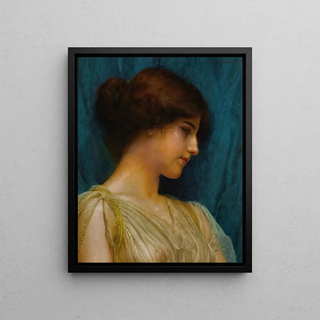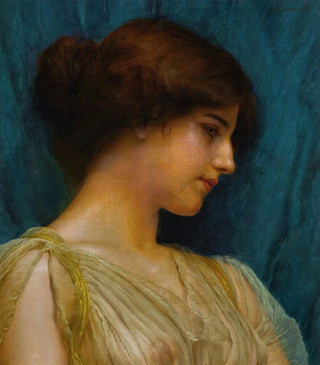Art print | Study of a Girl's Head - John William Godward


View from behind

Frame (optional)
In the vast panorama of art history, certain works stand out for their ability to capture the very essence of beauty and human sensitivity. "Study of a Girl's Head" by John William Godward is a striking example. This piece, emblematic of the Neoclassical movement and Pre-Raphaelite aesthetics, evokes a delicacy and finesse that invite contemplation. The depiction of a young girl, whose gaze appears both dreamy and introspective, transports the viewer into a universe where time seems suspended. The soft light caressing her face and the meticulous details of her features testify to an exceptional craftsmanship, making this piece a true ode to feminine beauty.
Style and uniqueness of the work
Godward's art is characterized by meticulous attention to detail and a palette of delicate colors that evoke a dreamlike atmosphere. In "Study of a Girl's Head," the artist manages to capture not only the physicality of his model but also an emotional depth that resonates with anyone who lingers on it. The delicate contours of the face, the texture of the hair, and the sparkle in the eyes are rendered with precision that borders on realism, while maintaining an almost mythical dimension. The pose of the young girl, slightly tilted, suggests vulnerability that attracts empathy, while the blurred background, which does not distract from her face, emphasizes the focus on the subject. This stylistic choice, combined with impeccable mastery of light and shadow, gives the work a timeless aura.
The artist and his influence
John William Godward, born in 1861, is often considered one of the last representatives of an artistic style that marked the end of the 19th century. Raised in a tradition that valued classical aesthetics, Godward was able to absorb influences from ancient masters while developing a unique voice. His works, often centered on female figures, testify to an admiration for beauty and grace. Godward was influenced by artists such as Sir Lawrence Alma-Tadema and the Pre-Raphaelites.

Matte finish

View from behind

Frame (optional)
In the vast panorama of art history, certain works stand out for their ability to capture the very essence of beauty and human sensitivity. "Study of a Girl's Head" by John William Godward is a striking example. This piece, emblematic of the Neoclassical movement and Pre-Raphaelite aesthetics, evokes a delicacy and finesse that invite contemplation. The depiction of a young girl, whose gaze appears both dreamy and introspective, transports the viewer into a universe where time seems suspended. The soft light caressing her face and the meticulous details of her features testify to an exceptional craftsmanship, making this piece a true ode to feminine beauty.
Style and uniqueness of the work
Godward's art is characterized by meticulous attention to detail and a palette of delicate colors that evoke a dreamlike atmosphere. In "Study of a Girl's Head," the artist manages to capture not only the physicality of his model but also an emotional depth that resonates with anyone who lingers on it. The delicate contours of the face, the texture of the hair, and the sparkle in the eyes are rendered with precision that borders on realism, while maintaining an almost mythical dimension. The pose of the young girl, slightly tilted, suggests vulnerability that attracts empathy, while the blurred background, which does not distract from her face, emphasizes the focus on the subject. This stylistic choice, combined with impeccable mastery of light and shadow, gives the work a timeless aura.
The artist and his influence
John William Godward, born in 1861, is often considered one of the last representatives of an artistic style that marked the end of the 19th century. Raised in a tradition that valued classical aesthetics, Godward was able to absorb influences from ancient masters while developing a unique voice. His works, often centered on female figures, testify to an admiration for beauty and grace. Godward was influenced by artists such as Sir Lawrence Alma-Tadema and the Pre-Raphaelites.






